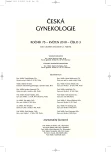Intensity modulated radiation therapy technique in the treatment of gynecologic malignancies
Authors:
I. Sirák; L. Kašaová; J. Petera; M. Vošmik
; Z. Zoul
Authors‘ workplace:
Klinika onkologie a radioterapie, Fakultní nemocnice Hradec Králové, vedoucí pracoviště prof. MUDr. J. Petera, Ph. D.
Published in:
Ceska Gynekol 2010; 75(3): 177-181
Overview
Objective:
A description of intensity modulated radiation therapy (IMRT) technique and its implementation in the treatment of gynecologic malignancies.
Subject:
A review article.
Setting:
Department of Oncology and Radiotherapy, University Hospital in Hradec Králové.
Subject and method:
General explanation of IMRT priciples, its benefits and limitations, and a review of published data about its utilization in the treatment of endometrial, cervical, and vulvar carcinoma.
Conclusion:
IMRT represents an accessible and highly conformal external beam radiothrapy technique, which enables a significant sparing of healthy tissue with consequent reduction of radiation morbidity in comparison with other conventional and conformal techniques. A feasibilty of dose excalation with preservation of low toxicity is another advandage of IMRT. It can be utilized in the treatment of most frequent gynecologic tumors, especially in endometrial, cervical, and vulvar carcinoma.
Key words:
IMRT, intensity modulated radiation therapy, endometrial carcinoma, cervical carcinoma, vulvar carcinoma.
Sources
1. Ahamad, A., D’Souza, W., Salehpour, M., et al. Intensity-modulated radiation therapy after hysterectomy: comparison with conventional treatment and sensitivity of the normal-tissue-sparing effect to margin size. Int J Radiat Oncol Biol Phys, 2005, 62(4), p. 1117-1124.
2. Ahmed, RS., Kim, RY., Duan, J., et al. IMRT dose escalation for positive para-aortic lymph nodes in patients with locally advanced cervical cancer while reducing dose to bone marrow and other organs at risk. Int J Radiat Oncol Biol Phys, 2004, 60(2), p. 505-512.
3. Beriwal, S., Gan, GN., Heron, DE., et al. Early clinical outcome with concurrent chemotherapy and extended-field, intensity-modulated radiotherapy for cervical cancer. Int J Radiat Oncol Biol Phys, 2007, 68(1), p. 166-171.
4. Beriwal, S., Coon, D., Heron, DE., et al. Preoperative intensity-modulated radiotherapy and chemotherapy for locally advanced vulvar carcinoma. Gynecol Oncol, 2008, 109(2), p. 291-295.
5. Beriwal, S., Heron, DE., Kim, H., et al. Intensity-modulated radiotherapy for the treatment of vulvar carcinoma: a comparative dosimetric study with early clinical outcome. Int J Radiat Oncol Biol Phys, 2006, 64(5), p. 1395-1400.
6. Beriwal, S., Jain, SK., Heron, DE., et al. Clinical outcome with adjuvant treatment of endometrial carcinoma using intensity-modulated radiation therapy. Gynecol Oncol, 2006, 102(2), p. 195-199.
7. Brahme, A., Roos, JE., Lax, I. Solution of an integral equation encountered in rotation therapy. Phys Med Biol, 1982, 27(10), p. 1221-1229.
8. Brixey, CJ., Roeske, JC., Lujan, AE., et al. Impact of intensity--modulated radiotherapy on acute hematologic toxicity in women with gynecologic malignancies. Int J Radiat Oncol Biol Phys, 2002, 54(5), p. 1388-1396.
9. Chen, MF., Tseng, CJ., Tseng, CC., et al. Clinical outcome in posthysterectomy cervical cancer patients treated with concurrent Cisplatin and intensity-modulated pelvic radiotherapy: comparison with conventional radiotherapy. Int J Radiat Oncol Biol Phys, 2007, 67(5), p. 1438-1444.
10. D’Souza, WD., Ahamad, AA., Iyer, RB., et al. Feasibility of dose escalation using intensity-modulated radiotherapy in posthysterectomy cervical carcinoma. Int J Radiat Oncol Biol Phys, 2005, 61(4), p. 1062-1070.
11. Hall, EJ. Intensity-modulated radiation therapy, protons, and the risk of second cancers. Int J Radiat Oncol Biol Phys, 2006, 65(1), p. 1-7.
12. Heron, DE., Gerszten, K., Selvaraj, RN., et al. Conventional 3D conformal versus intensity-modulated radiotherapy for the adjuvant treatment of gynecologic malignancies: a comparative dosimetric study of dose-volume histograms small star, filled. Gynecol Oncol, 2003, 91(1), p. 39-45.
13. Lujan, AE., Mundt, AJ., Yamada, SD., et al. Intensity-modulated radiotherapy as a means of reducing dose to bone marrow in gynecologic patients receiving whole pelvic radiotherapy. Int J Radiat Oncol Biol Phys, 2003, 57(2), p. 516-521.
14. Mundt, AJ., Lujan, AE., Rotmensch, J., et al. Intensity-modulated whole pelvic radiotherapy in women with gynecologic malignancies. Int J Radiat Oncol Biol Phys, 2002, 52(5), p. 1330-1337.
15. Mundt, AJ., Mell, LK., Roeske, JC. Preliminary analysis of chronic gastrointestinal toxicity in gynecology patients treated with intensity-modulated whole pelvic radiation therapy. Int J Radiat Oncol Biol Phys, 2003, 56(5), p. 1354-1360.
16. Portelance, L., Chao, KS., Grigsby, PW., et al. Intensity-modulated radiation therapy (IMRT) reduces small bowel, rectum, and bladder doses in patients with cervical cancer receiving pelvic and para-aortic irradiation. Int J Radiat Oncol Biol Phys, 2001, 51(1), p. 261-266.
17. Randall, ME., Ibbott, GS. Intensity-modulated radiation therapy for gynecologic cancers: pitfalls, hazards, and cautions to be considered. Semin Radiat Oncol, 2006, 16(3), p. 138-143.
18. Roeske, JC., Lujan, A., Rotmensch, J., et al. Intensity-modulated whole pelvic radiation therapy in patients with gynecologic malignancies. Int J Radiat Oncol Biol Phys, 2000, 48(5), p. 1613-1621.
19. Salama, JK., Mundt, AJ., Roeske, J., Mehta, N. Preliminary outcome and toxicity report of extended-field, intensity-modulated radiation therapy for gynecologic malignancies. Int J Radiat Oncol Biol Phys, 2006, 65(4), p. 1170-1176.
Labels
Paediatric gynaecology Gynaecology and obstetrics Reproduction medicineArticle was published in
Czech Gynaecology

2010 Issue 3
Most read in this issue
- G spot – myths and reality
- Incidence of congenital heart defects in the Czech Republic – current data
- Existence of the preperitoneal fatty plug and hernia in obtorator canal
- Modified classification of microscopic evaluation of vulvovaginal infections
